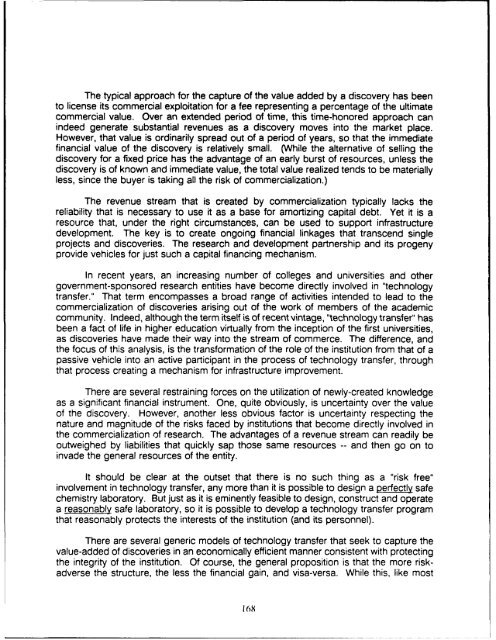Challenges and Opportunities for Innovation in the Public Works ...
Challenges and Opportunities for Innovation in the Public Works ...
Challenges and Opportunities for Innovation in the Public Works ...
Create successful ePaper yourself
Turn your PDF publications into a flip-book with our unique Google optimized e-Paper software.
The typical approach <strong>for</strong> <strong>the</strong> capture of <strong>the</strong> value added by a discovery has been<br />
to license its commercial exploitation <strong>for</strong> a fee represent<strong>in</strong>g a percentage of <strong>the</strong> ultimate<br />
commercial value. Over an extended period of time, this time-honored approach can<br />
<strong>in</strong>deed generate substantial revenues as a discovery moves <strong>in</strong>to <strong>the</strong> market place.<br />
However, that value is ord<strong>in</strong>arily spread out of a period of years, so that <strong>the</strong> immediate<br />
f<strong>in</strong>ancial value of <strong>the</strong> discovery is relatively small. (While <strong>the</strong> alternative of sell<strong>in</strong>g <strong>the</strong><br />
discovery <strong>for</strong> a fixed price has <strong>the</strong> advantage of an early burst of resources, unless <strong>the</strong><br />
discovery is of known <strong>and</strong> immediate value, <strong>the</strong> total value realized tends to be materially<br />
less, s<strong>in</strong>ce <strong>the</strong> buyer is tak<strong>in</strong>g all <strong>the</strong> risk of commercialization.)<br />
The revenue stream that is created by commercialization typically lacks <strong>the</strong><br />
reliability that is necessary to use it as a base <strong>for</strong> amortiz<strong>in</strong>g capital debt. Yet it is a<br />
resource that, under <strong>the</strong> right circumstances, can be used to support <strong>in</strong>frastructure<br />
development. The key is to create ongo<strong>in</strong>g f<strong>in</strong>ancial l<strong>in</strong>kages that transcend s<strong>in</strong>gle<br />
projects <strong>and</strong> discoveries. The research <strong>and</strong> development partnership <strong>and</strong> its progeny<br />
provide vehicles <strong>for</strong> just such a capital f<strong>in</strong>anc<strong>in</strong>g mechanism.<br />
In recent years, an <strong>in</strong>creas<strong>in</strong>g number of colleges <strong>and</strong> universities <strong>and</strong> o<strong>the</strong>r<br />
government-sponsored research entities have become directly <strong>in</strong>volved <strong>in</strong> "technology<br />
transfer." That term encompasses a broad range of activities <strong>in</strong>tended to lead to <strong>the</strong><br />
commercialization of discoveries aris<strong>in</strong>g out of <strong>the</strong> work of members of <strong>the</strong> academic<br />
community. Indeed, although <strong>the</strong> term itself is of recent v<strong>in</strong>tage, "technology transfer" has<br />
been a fact of life <strong>in</strong> higher education virtually from <strong>the</strong> <strong>in</strong>ception of <strong>the</strong> first universities,<br />
as discoveries have made <strong>the</strong>ir way <strong>in</strong>to <strong>the</strong> stream of commerce. The difference, <strong>and</strong><br />
<strong>the</strong> focus of this analysis, is <strong>the</strong> trans<strong>for</strong>mation of <strong>the</strong> role of <strong>the</strong> <strong>in</strong>stitution from that of a<br />
passive vehicle <strong>in</strong>to an active participant <strong>in</strong> <strong>the</strong> process of technology transfer, through<br />
that process creat<strong>in</strong>g a mechanism <strong>for</strong> <strong>in</strong>frastructure improvement.<br />
There are several restra<strong>in</strong><strong>in</strong>g <strong>for</strong>ces on <strong>the</strong> utilization of newly-created knowledge<br />
as a significant f<strong>in</strong>ancial <strong>in</strong>strument. One, quite obviously, is uncerta<strong>in</strong>ty over <strong>the</strong> value<br />
of <strong>the</strong> discovery. However, ano<strong>the</strong>r less obvious factor is uncerta<strong>in</strong>ty respect<strong>in</strong>g <strong>the</strong><br />
nature <strong>and</strong> magnitude of <strong>the</strong> risks faced by <strong>in</strong>stitutions that become directly <strong>in</strong>volved <strong>in</strong><br />
<strong>the</strong> commercialization of research. The advantages of a revenue stream can readily be<br />
outweighed by liabilities that quickly sap those same resources -- <strong>and</strong> <strong>the</strong>n go on to<br />
<strong>in</strong>vade <strong>the</strong> general resources of <strong>the</strong> entity.<br />
It should be clear at <strong>the</strong> outset that <strong>the</strong>re is no such th<strong>in</strong>g as a "risk free"<br />
<strong>in</strong>volvement <strong>in</strong> technology transfer, any more than it is possible to design a perfectly safe<br />
chemistry laboratory. But just as it is em<strong>in</strong>ently feasible to design, construct <strong>and</strong> operate<br />
a reasonably safe laboratory, so it is possible to develop a technology transfer program<br />
that reasonably protects <strong>the</strong> <strong>in</strong>terests of <strong>the</strong> <strong>in</strong>stitution (<strong>and</strong> its personnel).<br />
There are several generic models of technology transfer that seek to capture <strong>the</strong><br />
value-added of discoveries <strong>in</strong> an economically efficient manner consistent with protect<strong>in</strong>g<br />
<strong>the</strong> <strong>in</strong>tegrity of <strong>the</strong> <strong>in</strong>stitution. Of course, <strong>the</strong> general proposition is that <strong>the</strong> more riskadverse<br />
<strong>the</strong> structure, <strong>the</strong> less <strong>the</strong> f<strong>in</strong>ancial ga<strong>in</strong>, <strong>and</strong> visa-versa. While this, like most<br />
1 68







